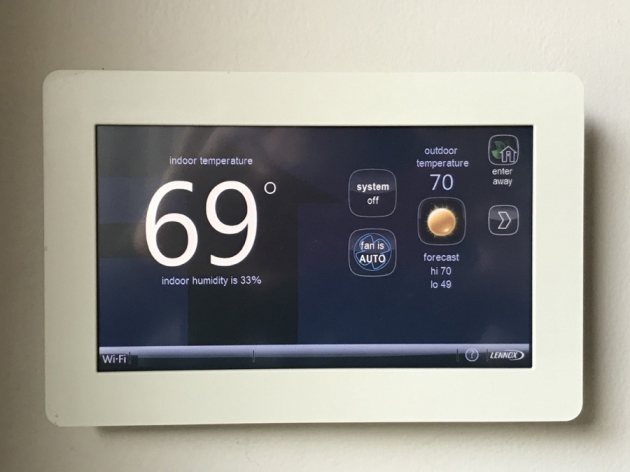The heating bills for a typical winter can add up to a significant amount of any family budget, and any steps that can be taken to reduce that figure are helpful. Many homeowners wonder if it’s even possible to reduce their energy usage without compromising on their levels of indoor comfort. Well, one easy place to start is the thermostat. This is the brain for the entire HVAC system, and any changes made here can have a dramatic effect on your household heating and cooling bills. If the thermostat is calibrated and set correctly for winter, the home can be kept warm, and the energy bills can be reduced at the same time. In this article, we will look at how you can optimize your thermostat for winter.
The Optimal Thermostat Settings for Winter Months
According to industry experts, the optimal temperature for an occupied home should be 72º. If the home is empty during the day or when everyone has gone to bed at night, the thermostat should be set a few degrees lower. The key to keeping a home comfortable and saving energy is to control this climate throughout the entire day. In the past, a simple thermostat with a dial would have set the temperature and maintained it at that level until the user adjusted it manually. This is very old technology now, and it’s a surefire way to waste money with higher energy bills. The latest programmable and smart thermostats are easier to control, flexible to use, and they can help the user to save a great deal of energy.
Using a Programmable Thermostat
If you install a modern programmable thermostat in your home, you don’t need to manually adjust the settings throughout the day. This is an easy way to “set it and forget it” for the everyday heating requirements for your home. The thermostat can be set to the optimal 72º mentioned above when your family is at home. When it’s time for bed or everyone has left for work, the timer will adjust the settings automatically. There are three main benefits of installing a programmable thermostat; they are:
- The thermostat can be set to gradually lower the temperature by a few degrees automatically at night. This will save energy on heating the home, and it will create conditions that are better suited to a good night’s rest.
- A 7 day schedule can be programmed into the thermostat to meet the needs of the entire family on weekdays and at the weekends. A typical family has a very different routine on a weekend, and this can be reflected in your thermostat settings. So, you can keep your home warm and comfortable 24/7, whether you’re working or enjoying a weekend with your family.
- The thermostat and, by extension, your furnace can be set to turn on or off automatically during the day. So, the temperature can be lower when no-one is home, and it can be raised just before the first family member returns.
Using a Smart Thermostat
A smart thermostat has all of the advantages of the programmable thermostat shown earlier, but it’s far more flexible and even easier to use. We’ve seen smart technologies become more prevalent in many aspects of our modern lives, and home heating and cooling is no exception. A smart thermostat can be controlled remotely via a dedicated app on your favorite smartphone, tablet, or computer. The temperature can be programmed in advance, much like a programmable thermostat, but it’s easier to make changes and monitor the system when you’re not at home. There are three main benefits to choosing a smart thermostat:
- A smart thermostat is a very flexible solution to control your heating and cooling. Because you have the app with you on your portable device, you can make adjustments remotely in real time. So, if you have to stay longer at work or you were delayed leaving for home, you can change the thermostat to meet your new needs. The thermostat can be set to turn on earlier or later, and you can adjust the temperature as you need to.
- Monitoring the entire HVAC system is very simple if you have a smart thermostat. The app will warn the user about impending air filter changes and the current level of performance. Certain aspects of the system can be adjusted to boost the performance and to improve the energy efficiency.
- Saving energy is very easy if you have a smart thermostat; there is no longer any need to waste energy when you’re not at home. The HVAC system can be set to bring the home up to the desired temperature 10-15 minutes before you return home.
Installing and Calibrating a New Thermostat
An existing programmable thermostat is vulnerable to a build-up of dust inside the housing. This will affect the operation of the sensors, even an error of 1º could add up to a significant and unnecessary cost over the course of a typical winter. Inspecting and cleaning your thermostat is included in a comprehensive annual service. A qualified HVAC technician can ensure that your thermostat is accurate and functioning correctly.
Installing a new thermostat is not as expensive as you may imagine, and an expert installation by a certified HVAC technician is highly recommended. The position of the thermostat can affect the performance, and it will need to be calibrated for the best results. If you’re not sure which programmable or smart thermostat to install, ask your HVAC company for advice on their recommendations.
In Conclusion
Many people go to extraordinary lengths to improve their energy efficiency, and they forget about their thermostat. The thermostat needs to working efficiently, and setting it at 72º during the day should be sufficiently warm to meet most people’s needs. If you have a thermostat that can adjust the heating automatically when you’re not at home, this is a great way to maintain your indoor comfort and save money at the same time.

